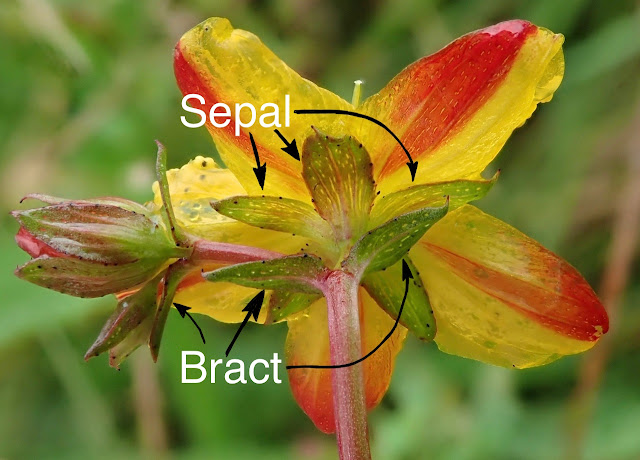St. John's-wort identification. Beginners Guide.
Britain and Ireland have 12 non-shrubby species of St. John's-worts plus a few shrubby species like Tutsan. All have attractive yellow flowers and many are widespread.
Following, is my non-expert attempt to produce a set of identification features to separate these 12 species, based on photos I have taken. The idea is to use it as an addition to your field guide which will include other information like flowering time and distribution maps. It attempts to give more detail than normally possible in a field guide.
The weasel word 'fairly' appears above because this group of species has pairs that can hybridise. This is especially true of the most common Perforate SJW and the Imperforate SJW and their hybrid know as 'Des Etangs' Hypericum x desetangsii. David J. Barden wrote an excellent paper on this hybrid, Hypericum maculatum-Hypericum perforatum complex in Cambridgeshire ( V.C. 29) published in Nature in Cambridgeshire Volume 52 2010 and available on their website.
The key finding for me in this paper, was the range of intermediate plants that David Barden separated into five groups. It showed me that some plants I had photographed and labelled as pure H. perforatum, were in fact not pure. It is however possible to find populations of Perforate SJW which appear pure and have no aberrant features, the 'perfect perforate'.
As always, plant ID should be based on a range of features, as no single feature is always 100% reliable.
This Key covers leaves (perforations and black dots), petals and sepals with attention to black glands and stem profile which should be looked at mid-stem, not just at the top. Use of X10 or X15 eyepiece will be expected unless you have very good eyesight.
Where the ID Key species boxes touch, this indicates that hybridisation can occur.
Finally the exact definition of a gland, is that it has a zone of secretion and this is clearly the case for the stalked glands on the sepals. The black dots on the leaves are also glands but I prefer to call them 'dots' because they just look like dark dots. Perforations which can be dots or lines are a feature of St John's-wort and are also glands. Glands contain hypericin and other chemicals which are an attempt to repel insects. These chemicals have been of medical interest and tend to dominate any web searches for any information regarding St. John's-wort's.
Peter G. Leonard May 2022 (Updated September 2022 with changes to Wavy and Toadflax-leaved SJW following visits to Devon and Pembrokeshire)
To print each page, click to highlight and save to downloads, then print from downloads. One correction needed is the difference in perforations between tetrapterum and undulatum which looking at more plants, does not really hold. See photo below Key. A more important point would be the flowers of tetrapterum are normally very crowded (except in shaded positions) and undulatum are not. The sepal shape and the number of black glands does really seem to work.
 |
| Left is Wavy (undulatum), right is Square-stalked (tetragonum). |





No comments:
Post a Comment